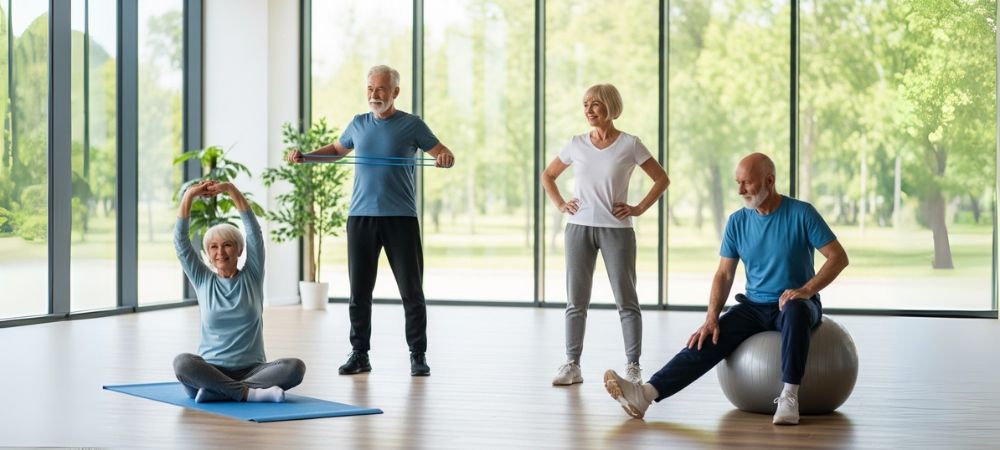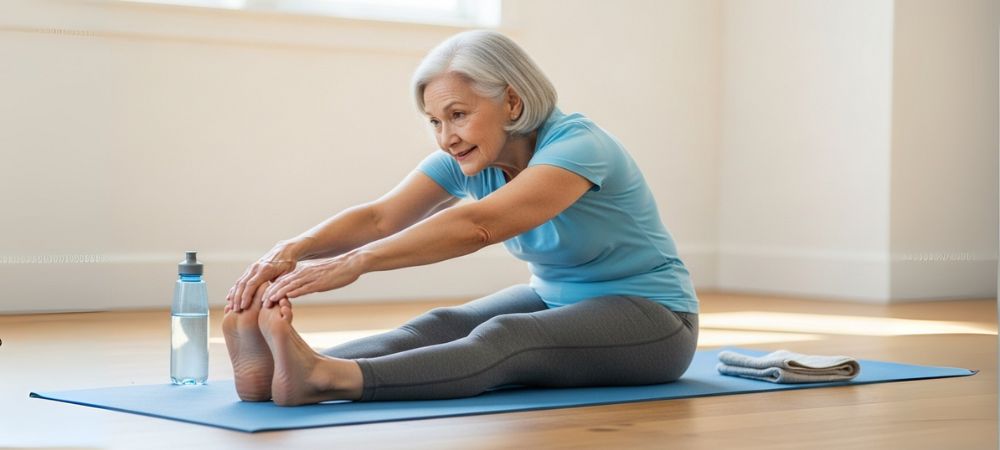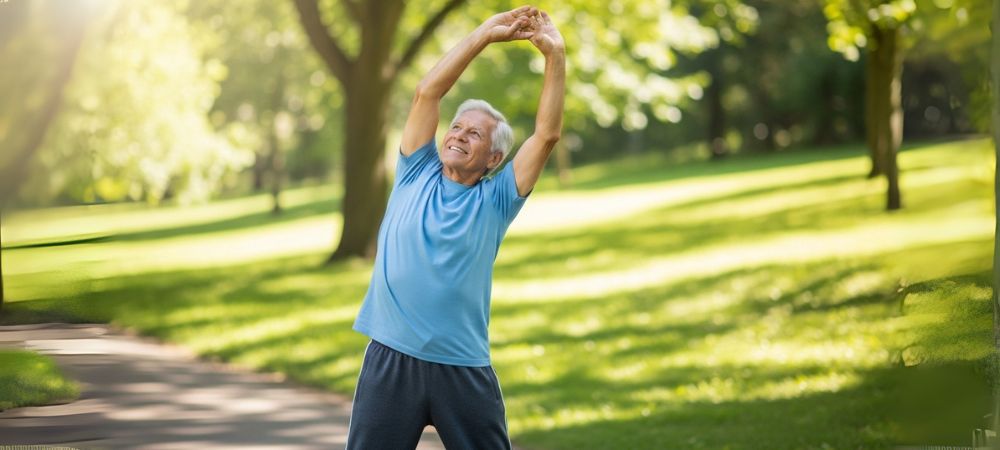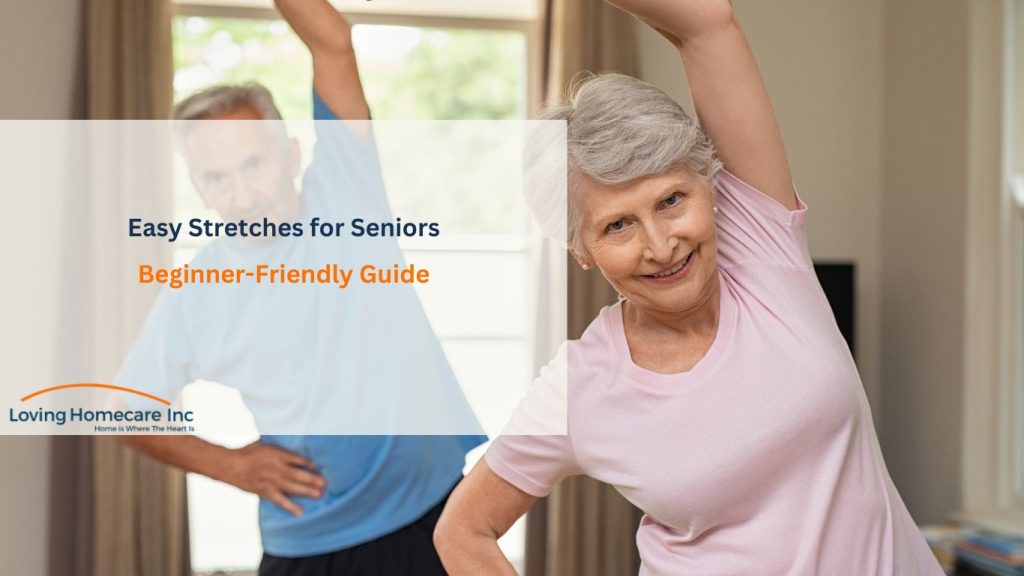Recently updated on October 15th, 2025 at 06:37 am
Are you feeling stiff, sore, or noticing reduced mobility as you age? Gentle stretches for elderly can help restore flexibility, reduce discomfort, and make daily movements easier. Before starting any new exercise routine, it’s important to consult your physician or a licensed physical therapist, especially if you have conditions such as osteoporosis, recent joint replacements, or severe arthritis.
Staying active is vital for seniors. Maintaining muscle tone and flexibility supports overall health, independence, and safety. According to the CDC, regular physical activity can prevent chronic diseases and improve quality of life for older adults.
This guide features 11 of the best stretching exercises for seniors, selected for safety, simplicity, and effectiveness. Incorporating these balance exercises and stretches for seniors can help maintain independence and prevent injuries caused by falls.
Disclaimer:
Stop immediately if you feel pain. These stretches should feel like gentle tension, not sharp pain. The National Institute on Aging recommends stretching at least 2-3 days per week for maintaining flexibility. If you have injuries or health concerns, consult a healthcare professional to determine the best stretches for your needs.
What are the Benefits of a Daily Stretching Routine for Seniors?

These exercises not only improve overall mobility but also help prevent injuries and enhance quality of life.
- Improves Flexibility and Range of Motion: Regular stretches for senior mobility and how to improve flexibility in old age help keep muscles supple and joints moving efficiently.
- Supports Balance and Fall Prevention: Incorporating balance exercises and stretches for seniors and stretching to prevent falls in seniors can significantly reduce the risk of falls.
- Relieves Pain and Stiffness: Gentle stretches like stretches for seniors with back pain, stretches for seniors with arthritis, and exercises to relieve stiffness in elderly can alleviate discomfort, enhance posture, and improve overall comfort.
- Promotes Safe Movement for Lower Body Issues: Chair exercises for seniors with knee pain and other targeted routines ensure that even those with limited mobility can safely stretch key muscle groups.
- Boosts Mental and Physical Well-being: A consistent routine not only supports physical health but also reduces stress, and encourages independence in daily activities.
11 Safe and Gentle Stretches for Seniors:
1. Neck Stretching
Steps:
- Sit in a comfortable chair with your feet flat on the ground.
- Slowly tilt your head toward your right shoulder until you feel a gentle stretch on the left side of your neck.
- Hold this position for 15–30 seconds.
- Return your head to the center and repeat on the left side.
Benefits:
- Relieves neck stiffness, common among seniors due to reduced mobility or arthritic changes.
- Enhances neck flexibility and may help reduce headaches and tension.
Importance for Seniors:
- Regularly performing this exercise as part of stretch exercises for seniors can improve the range of motion in the neck, making daily activities such as driving, reaching, and looking around easier and safer.
- This is one of the best stretching exercises for seniors to maintain overall upper-body mobility.
- For beginners, this is a great example of gentle stretching exercises for seniors, and can be included in a routine of stretching exercises for seniors with pictures for easy guidance.
2. Shoulder Rolls
Steps:
- Sit or stand with a straight spine.
- Slowly roll your shoulders in a circular motion: forward, up, back, and then down.
- Perform this motion five times.
- Reverse the direction and repeat.
Benefits:
- Increases shoulder mobility and reduces tension.
- Helps alleviate stiffness and pain caused by conditions like frozen shoulder or arthritis.
Importance for Seniors:
- Regularly including shoulder rolls in your daily stretching routine for seniors is essential for maintaining shoulder health.
3. Upper Back Stretch
Steps:
- Sit in a chair with your feet firmly on the floor.
- Clasp your hands and extend your arms in front of you.
- Lower your head slightly and gently round your upper back, pushing your hands forward.
- Hold this stretch for 20–30 seconds.
Benefits:
- Targets the upper back, helping to relieve tension and pain in this area.
- Improves posture, which often deteriorates in seniors, helping to prevent back and neck problems.
Importance for Seniors:
- Regularly practising this stretch as part of gentle stretches for the elderly can enhance spinal flexibility, improve balance, and reduce the risk of falls.
4. Ankle Circles
Steps:
- Sit comfortably and extend one leg out straight.
- Rotate your ankle slowly in a clockwise direction for 10 seconds.
- Switch to a counter-clockwise rotation for another 10 seconds.
- Repeat with the other leg.
Benefits:
- Enhances ankle flexibility and improves circulation.
- Helps prevent stiffness and reduces swelling, which is common in seniors.
Importance for Seniors:
- Including ankle circles in flexibility exercises for older adults supports ankle mobility, which is crucial for balance and safe walking.
5. Seated Hamstring Stretch

Steps:
- Sit at the edge of a chair with one leg extended out.
- Keep your back straight and lean forward gently from the hips.
- Hold the stretch for 20–30 seconds.
- Repeat with the other leg.
Benefits:
- Targets the hamstrings, reducing tightness and increasing flexibility.
- Can help alleviate back pain and improve lower body mobility.
Importance for Seniors:
- This stretch is highly effective as part of chair exercises for seniors with knee pain, helping maintain functional mobility without putting stress on the knees.
6. Wrist Stretch
Steps:
- Extend one arm forward with the palm facing up.
- Use your other hand to gently press down on the fingers of the extended hand.
- Hold this position for 15 seconds.
- Switch arms and repeat.
Benefits:
- Increases wrist flexibility and reduces stiffness.
- Can help prevent conditions like carpal tunnel syndrome.
Importance for Seniors:
- Incorporating this exercise into stretches for senior mobility helps maintain wrist health, which is vital for performing daily tasks that require dexterity, such as writing, cooking, or knitting.
7. Side Stretch
Steps:
- Stand or sit with feet shoulder-width apart.
- Raise one arm overhead and gently lean to the opposite side.
- Hold for 20 seconds.
- Return to the starting position and repeat with the other arm.
Benefits:
- Targets the muscles along the sides of the torso, improving flexibility.
- Helps open up the ribcage, enhancing breathing capacity.
Importance for Seniors:
- Including this exercise in stretching to prevent falls in seniors supports torso mobility, which is essential for safe bending, reaching, and daily movements.
8. Calf Stretch
Steps:
- Stand at arm’s length from a wall.
- Step one foot back, keeping it flat on the floor.
- Bend the front knee slightly and lean forward.
- Hold for 20–30 seconds, then switch legs.
Benefits:
- Targets the calf muscles, which are essential for walking, climbing stairs, and overall lower-leg strength.
- Helps prevent cramps and reduces the risk of lower-leg injuries.
Importance for Seniors:
- Including calf stretches in balance exercises and stretches for seniors supports lower-leg strength, flexibility, and stability.
9. Hip Stretch
Steps:
- While seated, place one ankle on the opposite knee.
- Gently lean forward, keeping your back straight.
- Hold the stretch for 20–30 seconds.
- Switch legs and repeat.
Benefits:
- Stretches the hip and buttock muscles, relieving tightness.
- Can improve hip mobility and reduce discomfort in the lower body.
Importance for Seniors:
- Hip flexibility is essential for seniors to perform everyday activities like walking, sitting, and bending comfortably.
- This stretch is also one of the most effective exercises for lower back pain for seniors, helping to relieve tension in the lower back while maintaining hip health and promoting better posture.
10. Spinal Twist
Steps:
- Sit upright in a chair with a straight back.
- Place your feet flat on the floor, hip-width apart.
- Cross your arms over your chest.
- Slowly turn your upper body to one side from the waist, keeping your hips and legs facing forward.
- Hold this twist for 20 seconds, feeling the stretch in your spine.
- Gently return to the starting position and repeat on the opposite side.
Benefits:
- Increases spinal mobility, which is crucial for maintaining good posture and reducing back pain.
- Stretches back muscles and can improve digestion due to the gentle pressure on the abdominal organs.
Importance for Seniors:
- Best home workouts for seniors help in reducing spinal flexibility due to age-related changes.
- Including the spinal twist as part of personal care for seniors helps keep the spine supple and functional, supporting everyday activities like turning, bending, and reaching.
11. Arm Stretch

Steps:
- Raise one arm and bend it at the elbow, attempting to touch the middle of your back with your hand.
- With your opposite hand, gently press on the bent elbow to deepen the stretch.
- Hold this position for 15 seconds.
- Carefully release and switch arms, repeating the stretch.
Benefits:
- Improves flexibility in the arms and shoulders.
- Helps relieve stiffness and discomfort in the upper body, which is common among seniors.
Importance for Seniors:
- Including the arm stretch in a daily stretching routine for seniors helps maintain the range of motion necessary for everyday tasks such as dressing, bathing, and reaching overhead.
- Regular practice supports shoulder and elbow mobility, promoting independence and ease in daily living.
How a Caregiver Can Help Seniors Stay Active Safely?
Our caregiver help with exercises so seniors maintain independence and safety while performing exercises designed to improve mobility and prevent injuries:
- Provide Standby Assistance: Seniors can perform stretches for senior mobility and balance exercises and stretches for seniors with confidence, knowing a caregiver is nearby to help prevent slips or falls.
- Offer Verbal Guidance and Encouragement: Our caregivers provide gentle cues to ensure movements are done safely, helping seniors improve flexibility in old age while reducing discomfort.
- Create Consistent Routines: Incorporating stretching to prevent falls in seniors into a daily routine reinforces healthy habits. Our caregivers can help structure exercises throughout the day, making movement a safe and regular part of life.
- Monitor Health and Safety: Seniors with pre-existing conditions, can perform exercises more effectively when a caregiver is present, ensuring that mobility improvements are achieved without compromising safety.
Concerned about your loved one’s mobility? Call Loving Homecare today to learn how our caregivers can support daily stretching routines, balance exercises, and overall mobility.
How In-Home Care Supports a Safe Exercise Routine?
For many families, the biggest concern is safety. Seniors often want to maintain mobility through in-home exercise assistance and balance exercises and stretches for seniors, but performing these exercises alone can sometimes be risky. That’s where professional in-home care makes a difference.
Our caregivers provide:
- Standby assistance to prevent falls during exercises.
- Guidance and encouragement to perform movements safely and correctly.
- Support for consistent routines, helping seniors stick to exercises designed to improve flexibility in old age.
This is a key component of our in-home fall prevention services, ensuring seniors enjoy the benefits of movement while staying safe and confident at home.
Contact Loving Homecare today for a free in-home assessment. Our caregivers specialize in assisting seniors with exercise routines, keeping them safe, active, and independent.
FAQs
Q: How often should a senior do these stretching exercises?
A: Seniors should aim to perform gentle stretching exercises at least 2–3 times per week. Daily sessions are ideal for maintaining flexibility, mobility, and overall muscle health.
Q: Can stretching help with arthritis pain in seniors?
A: Yes. Gentle stretching can reduce stiffness, improve joint flexibility, and alleviate discomfort associated with arthritis. Always consult a healthcare provider before starting new stretches.
Q: What’s the difference between stretching and a warm-up?
A: A warm-up increases blood flow and raises body temperature before exercise, preparing muscles and joints for movement. Stretching improves flexibility and range of motion, either before or after activity.
Q: How can a caregiver assist with a stretching routine safely?
A: Caregivers can provide support by offering balance assistance, gentle guidance on proper form, encouragement, and ensuring the senior performs stretches safely to prevent falls or injury.

